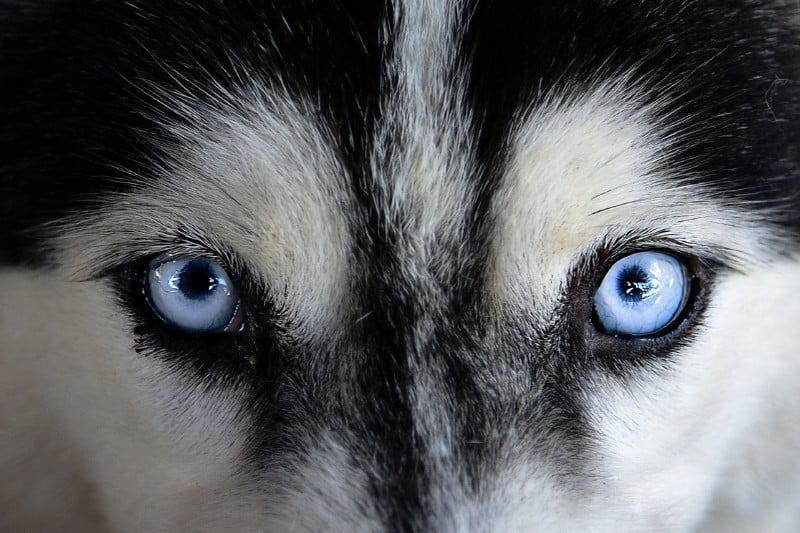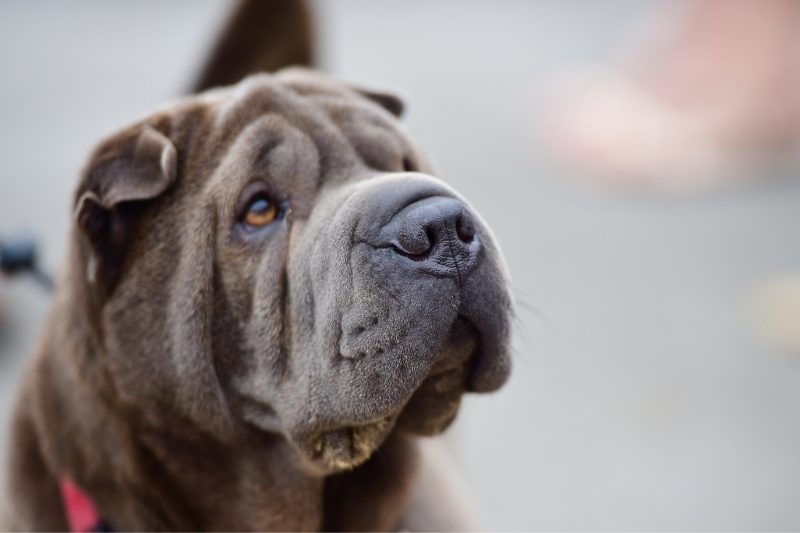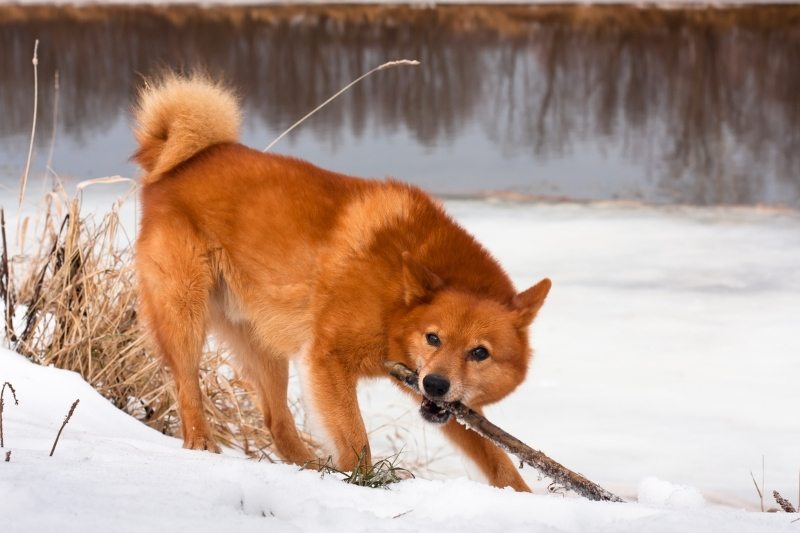All the Siberian Husky Eye Colors Explained (With Pictures!)

What’s the first thing you think of when someone mentions a Husky? Their seriously bushy tail? Their wolf-like features? Or is it all the incredible Husky eye colors?
I, for one, always think about those piercing ice-blue eyes that are so iconic for these dogs. But did you know that there are actually several different possible eye colors for Huskies?
In this article, we’re going to cover all the different Husky eye colors. We'll also look at the rarest ones, how to identify your pooch’s color, and any possible health risks associated with different eye colors.
Here’s what you need to know about these wonderful dogs and their beautiful eyes!
All the Husky Eye Colors (With Pictures)
Huskies are known for having beautiful, bright blue eyes. But these dogs can also have green, brown, parti-colored and two different colored eyes (usually one brown and one blue). All are perfectly healthy but only blue and brown are accepted by the American Kennel Club.

Blue Eyes

Whilst this isn’t the only Husky eye color, it is one of the most common (and beautiful)! However, the shade of blue can vary a lot between dogs. Some have deep blue eyes, whilst others have such light eyes they even look white.
Huskies with pale eyes often have a rim of dark skin around their eyes. This reflects sunlight and snow glare which helps when they’re racing or working. The dark skin and fur around the eyes also make the blue color stand out, making it even more striking!
Blue eyes are one of the standard eye colors accepted by the American Kennel Club.
Brown Eyes

Brown eyes are also common and one of the accepted colors by the American Kennel Club.
Brown eyes range from a light hazel color to a rich, chocolate brown. In fact, many owners mistake their Husky’s eyes for being black, but that’s just because they’re so dark the color can’t be distinguished from the pupil. Light brown eyes can sometimes look green too.
Something which confuses many owners and novice breeders is that two dogs with blue eyes can have Husky puppies with brown eyes (more on this later).
Green Eyes
Huskies with green eyes are quite rare, so we didn't find a picture! Do you have one? Send it to us by email!
Green eyes are not accepted in the AKC’s standard for this dog breed. It’s a rare eye color for Huskies, but a very beautiful one.
In actual fact, not a lot is known about these Husky eyes. Many think that the green color arises when milky blue puppy eyes change to brown. This might be because they don’t go through the full transition and end up with green rather than dark brown eyes!
Bi-Eyed Huskies

Many dog breeds including Border Collies, Australian Shepherds, and Dalmatians can have different colored eyes. This is caused by something called Heterochromia (which we’ll go into more detail later on).
Bi-eyes are much less common than other Husky eye colors. The most common bi-eyed combination is to have one blue eye and one brown eye, although green is also possible but very rare.
This eye color is considered standard for Huskies by the Siberian Husky Club of America.
Parti-Colored Eyes
Dogs with parti-colored eyes are particularly beautiful. One of their eyes will have two colors in it. If you haven’t seen a husky with parti- or bi-colored eyes it can be a little startling.
Many of us naturally think that they have an eye issue or can’t see – which isn’t true at all!
It’s most common for parti-colored dogs to have a mixture of brown and blue eyes that blend towards the edge of the eye.
According to the Siberian Husky Club of America, these eyes are also considered standard.
Husky Eyes: Color Genetics 101
So, we’ve gone through the different Husky eye colors, but why are there so many? And do you need to worry if your pup has bright blue eyes or different colored eyes?
The first thing to know is that all of the above-listed eye colors are normal and totally healthy. As long as your pup hasn’t injured its eye (which caused it to change color), there’s nothing to worry about.
Huskies inherit their eye color (as well as coat color and other characteristics) from their parents. Some genes are dominant and some are recessive.
For example, blue eyes are a recessive gene so both parents need to carry this gene for a puppy to have blue eyes. If one parent dog doesn’t carry the gene the puppy will probably have brown eyes.
But that doesn’t mean both parent dogs will have blue eyes. They just need to carry the blue gene. Depending on the parent dogs, your pooch will either have blue, brown, or green eyes.
Heterochromia is responsible for dogs that have partially or different colored eyes. This condition causes a lack of the pigment melanin in Husky eyes, making them appear pale blue. This can affect the entire eye (making the pup bi-eyed) or only part of the eye (making them parti-eyed).
According to Lawndale Vets, there are three different types of Heterochromia.
- Complete Heterochromia. This means your dog has two completely different colored eyes.
- Sectoral Heterochromia. Only part of the iris is non-pigmented and therefore appears blue and the other part is pigmented.
- Central Heterochromia. This is when the center of the iris is a different color to the outer area of the eye.
Heterochromia doesn’t affect the health of a Husky’s eye, it just makes it all the more striking!
For a couple of years, owners were worried about the effect pale eyes (caused by heterochromia) would have on UV damage. Nowadays, however, scientists don’t believe there is any relationship between Heterochromia and UV damage.
Some may think that Heterochromia is the result of cross-breeding. Again, this isn’t the case. Purebred Huskies can have eyes that are a mixture of colors and not have any other dog breed genetics at all. It’s completely normal for Huskies.
What’s the Rarest Eye Color for a Husky?
You might think that having two different colored eyes is pretty rare – but not in the case of Huskies. For this breed, having green eyes and parti-colored eyes is rarer.
The two standard eye colors (blue and brown) are much more common and are popular colors for owners who want to enter their pet into a competition or show.
Do Husky Eyes Change Over Time? What Age Do Siberian Husky Puppies’ Eyes Change?
Just like all dog breeds, Husky puppies are born with blue eyes. As they grow up, many dogs’ eyes change color depending on the amount of melanin they have and their unique genetics. Some may turn into brown-eyed Huskies and others may turn a darker shade of blue. Those that don’t fully transform may become green.
Pups might also go on to develop different-colored eyes or parti-colored eyes.
Most puppies' eyes will start to change between 5 and 8 weeks. Of course, if you have a blue-eyed puppy, it’s still possible for you to have a blue-eyed Husky – not all dogs’ eyes change color.
When Do Husky Eyes Stop Changing?
The change will be steady but at around 15 weeks you should see your dog’s final eye color. Don’t be surprised, however, if your pup’s eyes continue to transform. Some dogs don’t get their final eye color until they’re 6 months old.
If you notice your dog’s eye color changing after 6 months, you should take them to the vet to get checked as they may be suffering from an eye problem.
How To Determine Your Husky’s Eye Color?
Sounds easy enough, right? But determining your Husky’s exact eye color can be pretty tricky. But there are a few things you can do to make it easier.
- Know the possible colors. Do you think your Husky has white eyes? Well, this isn’t actually possible. White eyes are just very pale blue eyes, so your ‘white-eyed’ pooch is actually a blue-eyed Husky. The same goes for black and red.
- Remember that you can never be 100% sure of any puppy’s eye color when they grow up. As we already mentioned, some dogs’ eyes keep changing until they’re 6 months old. So, even if you get a puppy with blue eyes, there’s no sure guarantee you’ll have a grown Husky with the same eye color. This is also a reason not to enter your dog into a show or competition too early (the same goes for coat color). Eye and coat color can change, so you want to be sure they’re fully transformed and meet the breed standard to compete.
- If you want to be sure about your dog’s eye color, check it in natural sunlight. This is the best way to truly see the color or colors in their eyes. Avoid using torches and other lights as they can reflect light, causing the eye to look a different color to what it actually is.
- Make sure you check with your breeder. A trusted breeder should understand genetics and let you know the likelihood of your pup having blue/green/brown/parti/bi eyes based on the parent dogs. They won’t be able to tell you for sure, but they’ll have a better sense than most people!
Common Problems and Eye Diseases in Huskies
Unfortunately, Huskies can suffer from eye conditions and diseases – regardless of their eye color. Common eye problems can be serious, so make sure you take your pup to the vet if you suspect anything.
Hereditary/Juvenile Cataracts
According to the Siberian Husky Club of America, “hereditary or juvenile cataracts are manifested by opacity in the lens of a young dog as early as 3 months of age”. These aren’t the same kind of cataracts that affect older dogs.
The lens allows a dog to form an image on the retina. If the lens is cloudy, less light will pass through it and cause impaired eyesight or total blindness. In most cases, this type of cataract occurs on the posterior region of the lens.
Scientists are still conducting research to determine the exact cause of hereditary/juvenile cataracts. There’s evidence to suggest they’re carried by a recessive gene.
Tests are being developed to be used by breeders to ensure that dogs with this recessive gene won’t be bred in the future.
Take your dog to the vet if you suspect they have a cataract. If caught early on, something as simple as drops may be the cure!
Progressive Retinal Atrophy
Progressive Retinal Atrophy (PRA) is one of the most serious eye conditions a dog can have. PRA affects the rods in the retina which are responsible for sight in low light (or night light) and bright light. According to the Siberian Husky Club of America, this breed suffers from a unique type of PRA that's only found in these working dogs and humans.
This type of PRA is called X Linked PRA because it’s transmitted through the XX chromosomes of the female. Your dog will first lose its night vision, then day vision, and then suffer from total blindness.
Although there’s no cure for PRA, there is a reliable test that breeders should be using to ensure dogs with this gene don’t breed further. Trustworthy breeders should be able to provide you with all the necessary tests to prove that you’re getting a puppy that doesn’t have a carrier parent.
Corneal Dystrophy
Corneal Dystrophy affects the cornea of your pup’s eye (the transparent outer layer). Just like cataracts, your pup might have a cloudy eye because of the abnormal collection of lipids in the eye.
This condition tends to affect young female dogs more than others. There’s no known cure for Corneal Dystrophy but, luckily, in most cases, your dog’s eyesight won’t be affected.
Frequently Asked Questions
Why Do Huskies Have Light Eyes?
Lots of dog breeds, including Weimaraner, Dachshund, and Catahoula Cattle Dogs, can have blue eyes. It's totally normal and not an indication of an eye condition or disease. In fact, in Huskies, blue eyes are acknowledged by the AKC and are one of the most popular Husky eye colors.
Heterochromia causes Huskies (and other dog breeds) to have different colored eyes or partially colored eyes. It affects the amount of melanin and causes the eye to be partially or entirely light blue.
Can a Husky Have Different Eye Colors?
Yes! Huskies can absolutely have different-colored eyes. It’s normal for this dog breed (and others) and doesn’t affect their eyesight. The most common combination is for them to have one blue and one brown eye, although they can also have one green eye (but this is very rare).
Can Huskies Have Red Eyes?
It might sound a little demonic, but many owners claim their Husky has red eyes. The actual truth is that their dogs have brown eyes. As we already mentioned, there’s a huge range when it comes to shades of brown eyes. Some dogs have very dark brown eyes and others have very light-colored ones. Another is a beautiful chestnut/red color, which can look more red than chestnut in certain lights!
If your dog’s eye looks more red than usual, it may be down to an eye problem or infection. Take them to the vet if it looks inflamed or there are clear signs of an infection or your dog seems irritated by it.
Can Huskies Have White Eyes?
This is another common (but easy) mistake to make with the breed. Many dogs appear to have white eyes but they’re actually blue-eyed Huskies! Some pups have such pale eyes that they can appear white – especially when surrounded by darker skin and fur.
If your dog’s eyes start to appear paler or white, take them to the vet. A cloudy white eye may be caused by a cataract and should be checked out.
Why Does My Husky Have Yellow Eyes?
It’s not actually possible for Huskies to have yellow eyes. They can have very pale brown eyes which look golden and yellow in certain lights. Green eyes can also sometimes look a bit yellow.
If you notice the white around your dog’s eye turning yellow, or the eye color changes to yellow, take your pup to the vet for a check-up. This may be caused by an eye disease or infection.
Do Huskies Go Blind?
Just like all dogs, Huskies can go blind – but this isn’t a result of their eye color. It is common for Huskies to suffer from a couple of eye conditions though. The more serious ones, such as Progressive Retinal Atrophy will eventually cause blindness.
Other diseases may cause blindness if not caught early on, so it’s important to take your pooch to the vet for regular check-ups. You also need to adopt your dog from a reputable breeder that carries out different health checks to ensure dogs with hereditary eye conditions are not bred further.
Why Are Huskies’ Eyes So Blue?
Because it makes them so eye-catching! It’s totally normal for these dogs to have light and dark blue eyes and it doesn’t mean they have an eye problem. They can even have partially blue eyes or one blue eye and another of a different color.
Husky eyes can sometimes appear bluer because of the black skin or darker fur around the eyes. One thing is for sure – blue eyes are striking and very beautiful!
Final Thoughts: Husky Eye Colors
Huskies can have blue, brown, green, partial, and bi-colored eyes but only blue and brown are accepted by the AKC.
Whilst all of them are beautiful, you shouldn’t adopt a Husky based on their eye color alone. This breed can be a bit tricky – especially for first-time owners.
They’re known escape artists and need a lot of daily exercise which can be difficult for some to keep up with. They require lots of engaging training, early socialization, and will benefit from obedience classes too.
One thing is for sure – regardless of which color eyes your Husky has, they’ll use them to get into (and out of!) all sorts of trouble. You won’t be able to go far down the street without someone commenting on how beautiful your Husky’s eyes are!
I’m Charlotte, a content and copywriter from the North of England and currently living in Berlin. Animals have always been a huge part of my life, so writing about dogs is a total pleasure! I love all kinds of dogs and their cheeky personalities, but I’d have to say Weimaraners are my favourite!








